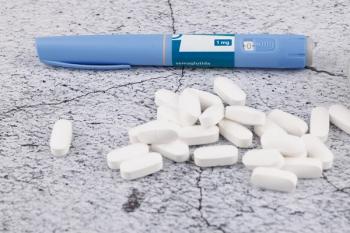
SGLT-2 Inhibitors Decrease Risk of Serious Liver Events
Among patients with cirrhosis receiving diuretic therapy, researchers explore the association between SGLT-2 inhibitors and the risk of serious liver outcomes.
The use of sodium-glucose cotransporter 2 (SGLT-2) inhibitors were associated with a decreased risk of serious liver events among patients with cirrhosis, according to data published in JAMA Network Open.1
“[SGLT-2] inhibitors are a class of antihyperglycemic agents that act by inhibiting the SGLT proteins in the proximal convoluted tubules of the kidney,” wrote the authors. “By inhibiting this protein, SGLT-2 inhibitors limit the reabsorption of filtered sodium and glucose, thereby enhancing urinary glucose excretion, natriuresis, and improving urine output.”
When discussing the growing use of SGLT-2 inhibitors, the medication class has been almost mutually exclusive with the treatment of type 2 diabetes (T2D). Four of the common SGLT-2s include anagliflozin, dapagliflozin, empagliflozin, and ertugliflozin—which were all approved for treating T2D.2
READ MORE:
However, alongside SGLT-2 inhibitors, glucagon-like peptide-1 (GLP-1) medications have also been growing in use and popularity, specifically in the T2D population. But as further research is conducted, both medication classes have shown promising outcomes outside of those for treating T2D.
“Altogether, SGLT2 inhibitors and GLP-1 [receptor] agonists constitute highly effective therapy agents in terms of cardiorenal outcomes,” wrote authors of a study published in the Journal of Cardiovascular Development and Disease.3 “Although originally incorporated into T2D treatment algorithms, emerging evidence extends their use. Considering the large amount of data that is appearing at present, it is plausible that, soon, new groups of patients would benefit from the use of SGLT2 inhibitors or GLP-1 [receptor] agonists regardless of T2D.”
The current study is an example of researchers attempting to test and report extended benefits of these emerging drug classes. Specifically, they explored how SGLT-2 inhibitors may impact patients with cirrhosis because of the medications’ diuretic and natriuretic effects. With many patients in this population being prescribed diuretic therapies such as spironolactone and furosemide, researchers believe SGLT-2s can promote similar effects.
“The natriuretic and diuretic effects of SGLT-2 inhibitors could help manage fluid overload while potentially reducing the need for large-volume paracentesis,” they continued.1 “Given the lack of current data on the safety or efficacy of SGLT-2 inhibitors in patients with cirrhosis, we hypothesized that these agents were associated with a reduced risk of serious liver events in patients with cirrhosis on diuretic therapy.”
Using TriNetX data from over 120 health care organizations, researchers gathered a cohort of adults with cirrhosis prescribed furosemide and spironolactone from January 2013 to July 2021. Comprising 2 cohorts within the study, a group of patients on SGLT-2 inhibitors plus furosemide and spironolactone was matched in a 1:1 ratio with patients just taking furosemide and spironolactone.
All patients included in the study were followed up for a 3-year period, ending in July of 2024. The final analysis included a total of 10,660 matched patients (mean age, 63.8 years; 57.8% men), meaning 5330 were taking SGLT-2 inhibitors plus furosemide and spironolactone, while the other 5330 participants were just taking furosemide and spironolactone.
“The study’s main outcome was the incidence of serious liver events (ie, a composite variable comprised of ascites, esophageal, or gastric varices with or without bleeding, hyponatremia, or all-cause mortality),” the authors wrote.1 “Compared with furosemide and spironolactone alone, use of SGLT-2 inhibitors with concurrent furosemide and spironolactone was associated with a statistically significant reduction in the risk of serious liver events.”
Aside from the positive impacts they have on liver events, the use of SGLT-2 inhibitors also resulted in a reduced risk of cirrhosis complications, which was the researchers’ secondary outcome. The researchers’ findings support their suggestion that the benefits of SGLT-2 inhibitors reach beyond T2D and into populations with cirrhosis.
GLP-1 medications have increased drastically in recent history because of their weight-loss effects and growing efficacy among people with diabetes. While SGLT-2 inhibitors and their benefits have not been investigated as significantly as GLP-1s, studies like this show that yet another diabetes-focused drug can extend its benefits beyond the populations they were approved for.
“In this cohort study of patients with cirrhosis who were receiving furosemide and spironolactone, SGLT-2 inhibitor use was associated with a lower risk of serious liver events, defined as incidence of ascites, variceal development, hyponatremia, or all-cause mortality,” they concluded.1 “These findings suggest that SGLT-2 inhibitors may offer potential liver-related benefits in patients with cirrhosis. Prospective trials are needed to further evaluate their safety and efficacy.”
READ MORE:
Pharmacy practice is always changing. Stay ahead of the curve: Sign up for our
REFERENCES
1. Abu-Hammour M, Abdel-Razeq R, Vignarajah A, et al. Sodium-glucose cotransporter 2 inhibitors and serious liver events in patients with cirrhosis. JAMA Netw Open. 2025;8(6):e2518470. doi:10.1001/jamanetworkopen.2025.18470
2. Padda IS, Mahtani AU, Parmar M. Sodium-glucose transport protein 2 (SGLT2) inhibitors. [Updated 2023 Jun 3]. StatPearls Publishing. 2025.https://www.ncbi.nlm.nih.gov/books/NBK576405/
3. Rolek B, Haber M, Gajewska M, et al. SGLT2 inhibitors vs. GLP-1 agonists to treat the heart, the kidneys and the brain. J Cardiovasc Dev Dis. 2023 Jul 30;10(8):322. doi: 10.3390/jcdd10080322.
Newsletter
Pharmacy practice is always changing. Stay ahead of the curve with the Drug Topics newsletter and get the latest drug information, industry trends, and patient care tips.





























































































































